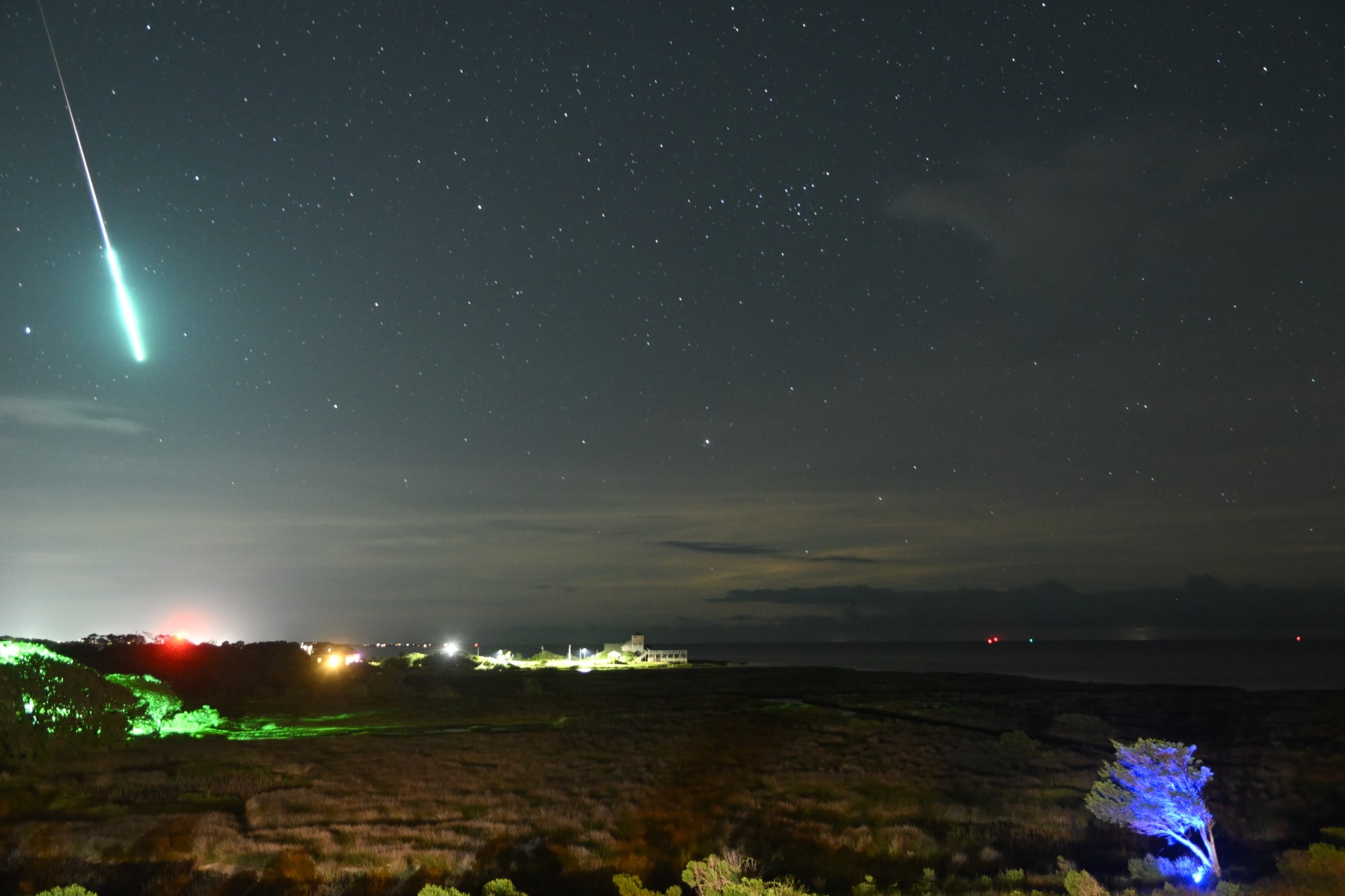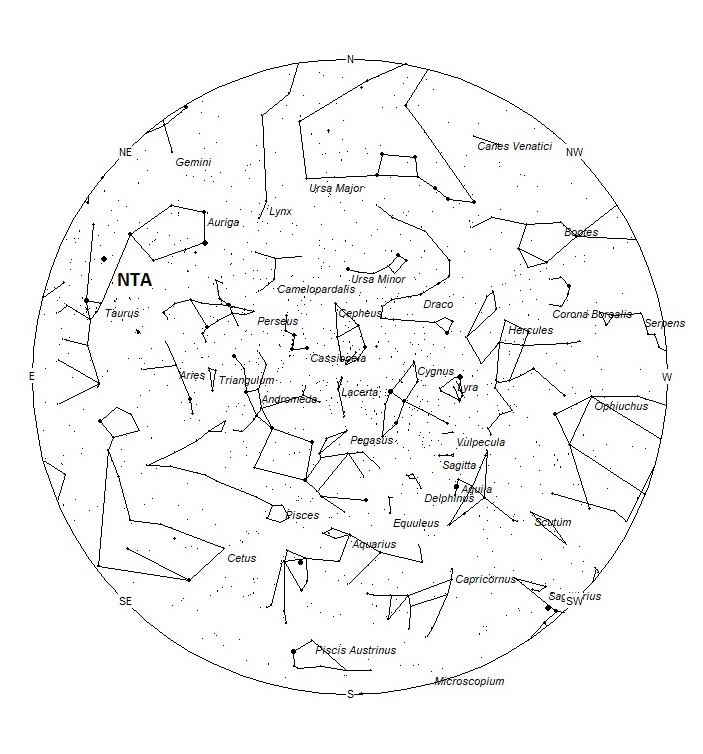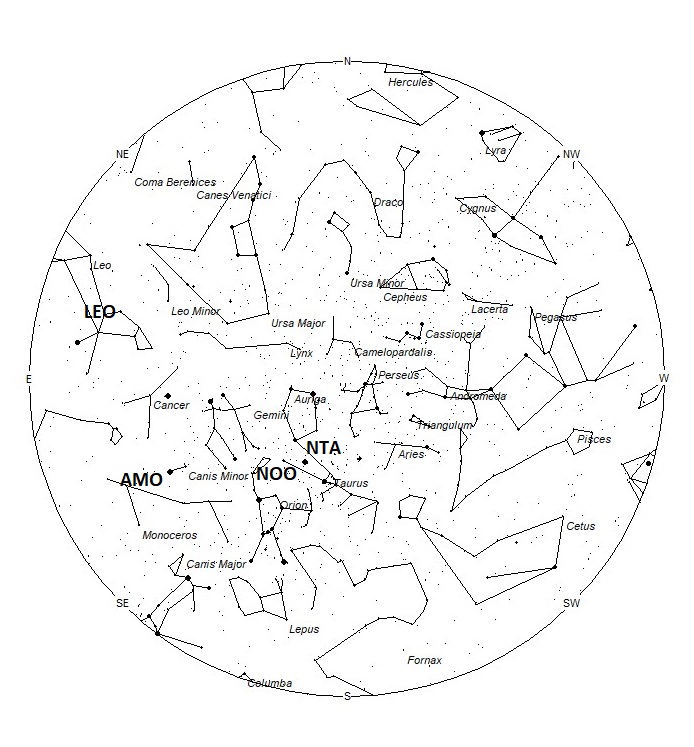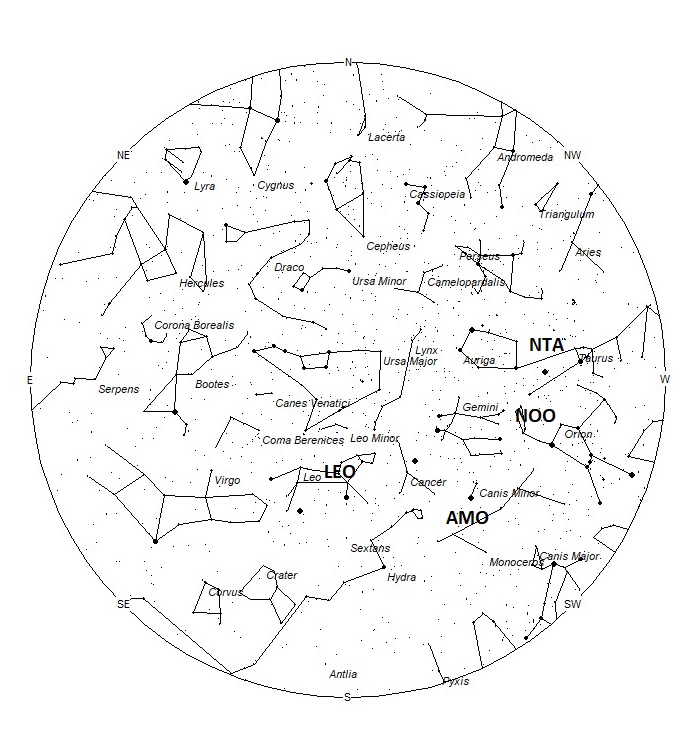
During this period, the moon reaches its last quarter phase on Saturday November 23rd. At that time the half-illuminated moon will rise near 23:00 Local Standard Time (on the previous evening) and will remain above the horizon the remainder of the night. Successful meteor observations are possible this weekend if you keep the moon out of your field of view. Viewing conditions improve with each passing night as the moon wanes and rises closer to dawn. The estimated total hourly rates for evening observers this weekend should be near 4 as seen from mid-northern latitudes (45N) and 3 as seen from tropical southern locations (25S). For morning observers, the estimated total hourly rates should be near 16 as seen from mid-northern latitudes (45N) and 10 as seen from tropical southern locations (25S). Morning rates are reduced during this period due to moonlight. The actual rates seen will also depend on factors such as personal light and motion perception, local weather conditions, alertness, and experience in watching meteor activity. Note that the hourly rates listed below are estimates as viewed from dark sky sites away from urban light sources. Observers viewing from urban areas will see less activity as only the brighter meteors will be visible from such locations.
The radiant (the area of the sky where meteors appear to shoot from) positions and rates listed below are exact for Saturday night/Sunday morning November 23/24. These positions do not change greatly day to day so the listed coordinates may be used during this entire period. Most star atlases (available online and at bookstores and planetariums) will provide maps with grid lines of the celestial coordinates so that you may find out exactly where these positions are located in the sky. I have also included charts of the sky that display the radiant positions for evening, midnight, and morning. The center of each chart is the sky directly overhead at the appropriate hour. These charts are oriented for facing south but can be used for any direction by rotating the charts to the desired direction. A planisphere or computer planetarium program is also useful in showing the sky at any time of night on any date of the year. Activity from each radiant is best seen when it is positioned highest in the sky, either due north or south along the meridian, depending on your latitude. Radiants that rise after midnight will not reach their highest point in the sky until daylight. For these radiants, it is best to view them during the last few hours before dawn. It must be remembered that meteor activity is rarely seen at its radiant position. Rather they shoot outwards from the radiant, so it is best to center your field of view so that the radiant lies toward the edge and not the center. Viewing there will allow you to easily trace the path of each meteor back to the radiant (if it is a shower member) or in another direction if it is sporadic. Meteor activity is not seen from radiants that are located far below the horizon. The positions below are listed in a west to east manner in order of right ascension (celestial longitude). The positions listed first are located further west therefore are accessible earlier in the night while those listed further down the list rise later in the night.
These sources of meteoric activity are expected to be active this week
.
The Northern Taurids (NTA) are active from a radiant located at 04:36 (69) +24. This area of the sky is located in central Taurus, 1 degree northwest of the 4th magnitude star known as the tau Tauri. To best see these meteors, one should face southward near 01:00 LST. Current hourly rates are expected to be near 2 for those in the northern hemisphere and 1 for those viewing from south of the equator. With an entry velocity of 29 km/sec., the average NTA meteor would be of medium-slow velocity.
The November Orionids (NOO) are active from November 13 through December 12, with maximum activity occurring on November 28th. The radiant is currently located at 05:48 (087) +16. This area of the sky lies in the northeastern Orion, 4 degrees northwest of the 4th magnitude star known as nu Orionis. This radiant is best placed in the southern sky near 0300 LST, when it lies highest above the horizon. Hourly rates should be near 2 per hour as seen from the northern hemisphere and 1 per hour as seen from south of the equator. With an entry velocity of 44 km/sec., most activity from this radiant would be of medium speed.
The alpha Monocerotids (AMO) are best known for their occasional outbursts, the last which occurred in 2019. These meteors are active from 13-27 November with maximum occurring on the 22nd. Rates away from the night of maximum are very low, far less than 1 per hour no matter your location. The radiant is currently located at 07:55 (119) +01. This area of the sky is located in northeastern Canis Minor, 4 degrees southeast of the zero-magnitude star known as Procyon (alpha Canis Minoris A). To best see these meteors, face toward the south during the last couple of hours prior to dawn. With an entry velocity of 65km/sec, most of these meteors would appear swift.
The Leonids (LEO) are active from October 27 to December 7 with maximum activity occurring on November 17th. The radiant is currently located at 10:24 (156) +20. This position lies in central Leo, near the spot occupied by the 2nd magnitude double star known as Algieba (gamma Leonis). The Leonid radiant is best placed in the eastern sky during the last hour before morning twilight when the radiant lies highest in a dark sky. Leonids may be seen from the southern hemisphere, but the viewing conditions are not quite as favorable as those north of the equator. Current rates are expected to be near 1 per hour as seen from the northern hemisphere and less than 1 per hour as seen from the southern hemisphere. With an entry velocity of 71 km/sec., most activity from this radiant would be of swift speed with numerous persistent trains on the brighter meteors.
Sporadic meteors are those meteors that cannot be associated with any known meteor shower. All meteor showers are evolving and disperse over time to the point where they are no longer recognizable. Away from the peaks of the major annual showers, these sporadic meteors make up the bulk of the activity seen each night. As seen from the mid-northern hemisphere (45N) one would expect to see during this period approximately 10 sporadic meteors per hour during the last hour before dawn as seen from rural observing sites. Evening rates should be near 3 per hour. As seen from the tropical southern latitudes (25S), morning rates would be near 7 per hour as seen from rural observing sites and 2 per hour during the evening hours. Locations between these two extremes would see activity between these listed figures. Evening rates are reduced due to moonlight.
The list below offers the information in tabular form. Rates and positions are exact for Saturday night/Sunday morning.
| SHOWER | DATE OF MAXIMUM ACTIVITY | CELESTIAL POSITION | ENTRY VELOCITY | CULMINATION | HOURLY RATE | CLASS |
| RA (RA in Deg.) DEC | Km/Sec | Local Standard Time | North-South | |||
| Northern Taurids (NTA) | Nov 12 | 04:36 (069) +24 | 29 | 01:00 | 2 – 1 | II |
| November Orionids (NOO) | Nov 28 | 05:48 (087) +16 | 44 | 02:00 | 2 – 1 | II |
| alpha Monocerotids (AMO) | Nov 21 | 07:56 (119) +00 | 65 | 04:00 | <1 – <1 | III |
| Leonids (LEO) | Nov 17 | 10:14 (156) +20 | 71 | 06:00 | 1 – <1 | I |
Class Explanation: A scale to group meteor showers by their intensity:
- Class I: the strongest annual showers with Zenith Hourly Rates normally ten or better.
- Class II: reliable minor showers with ZHR’s normally two to ten.
- Class III: showers that do not provide annual activity. These showers are rarely active yet have the potential to produce a major display on occasion.
- Class IV: weak minor showers with ZHR’s rarely exceeding two. The study of these showers is best left to experienced observers who use plotting and angular velocity estimates to determine shower association. These weak showers are also good targets for video and photographic work. Observers with less experience are urged to limit their shower associations to showers with a rating of I to III.







 You saw something bright and fast? Like a huge shooting star? Report it: it may be a fireball.
You saw something bright and fast? Like a huge shooting star? Report it: it may be a fireball.  You counted meteors last night? Share your results with us!
You counted meteors last night? Share your results with us!  You took a photo of a meteor or fireball? You have a screenshot of your cam? Share it with us!
You took a photo of a meteor or fireball? You have a screenshot of your cam? Share it with us!  You caught a meteor or fireball on video? Share your video with us!
You caught a meteor or fireball on video? Share your video with us!